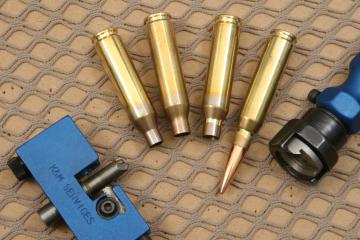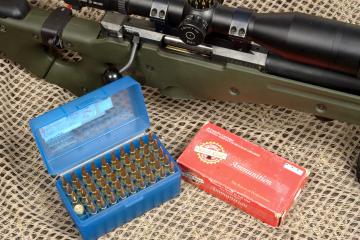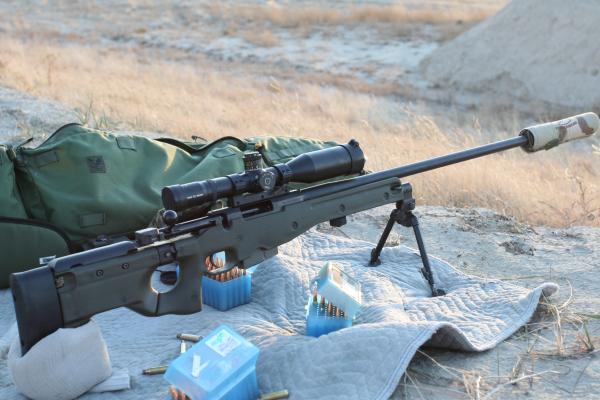.260 Remington
The .260 Remington is the commercial version of the 6.5mm wildcat based on the .308 Winchester case,
productized in 1997 by Remington. Brass can easily by formed by simply necking up .243 or necking
down 7mm-08 or .308 brass; however, care must be taken with regard to the resulting neck thickness.
The Gun
In spring 2007, I had George Gardner of GA Precision chamber a 26-inch medium-Palma contour 6.5 mm
barrel from Rock Creek in .260 Remington and fit it to an Accuracy International AW (AI-AW) rifle.
The length and contour duplicate the profile of the AI factory 26-inch 308 barrel. The rifle was
topped with a S&B 3-12x50mm PMII scope. On the muzzle, I used a 1.5x9" titanium sound suppressor
(designed for .308) most of the time, backing up to the AI single-chamber muzzle brake when I
couldn't use the "can" for whatever reason.
Bottom-line: Load, Ballistics, Accuracy
Final load: 139gr Lapua Scenar @ 2820 fps, 40.7gr H4350, CCI BR2, Lapua .243 brass necked up.
From a 100-yard zero, this load needs 7.4 mils of elevation to 1000 yards, and will drift 53 inches with a 10 mph cross. Accuracy is excellent at 1/4 MOA. November 2009 Update!
2011 Update!
260 139 @ 2820 Zero 100yd 5000' Density Altitude RANGE ELEV- moa mil | WIND(10) moa mil RANGE 100 0" 0.00 0.0mil | 0" 0.50 0.1mil 100 200 3" 1.25 0.4mil | 2" 0.75 0.2mil 200 300 11" 3.50 1.0mil | 4" 1.25 0.4mil 300 400 25" 6.00 1.7mil | 7" 1.75 0.5mil 400 500 45" 8.50 2.5mil | 12" 2.25 0.7mil 500 600 72" 11.50 3.3mil | 17" 2.75 0.8mil 600 700 107" 14.50 4.2mil | 24" 3.25 1.0mil 700 800 151" 18.00 5.2mil | 32" 3.75 1.1mil 800 900 204" 21.50 6.3mil | 42" 4.50 1.3mil 900 1000 267" 25.50 7.4mil | 53" 5.00 1.5mil 1000 
Load Development Notes
I originally tried using the Remington .260 brass. The primers pockets started off a little loose,
and the brass was very soft. With standard loads, I had a problem with gas seeping around the
primer and leaving a "soot" ring where the primer met the brass. This was present even with loads
that exhibited "zero" case-head expansion.
I also learned that the pressure limiter in the system would be piercing primers. The AI-AW is set up to be utterly reliable in harsh field conditions and ignite mil-spec 308 primers. In guns built from the ground up for a very high pressure cartridge, it's common to bush the firing pin hole and then control the pin protrusion. I wanted to leave this rifle at the military spec, not to mention that a replacement bolt head from AI in the UK would be very expensive, so I left it and lived with the results. I shot and won the 2006 Blue Steel Ranch Steel Safari match using loads in R-P brass, but had to toss half my brass after the match due to gas seepage. Transitioning to the Lapua brass, I used a K&M 6.5 mm mandrel and neck-turning tool from PrecisionReloading.com to make .260 Remington brass from the Lapua .243 Winchester brass. The results are excellent, uniform, and hard cases that last even with hot loads. The downside of using formed 243 brass is that brass prep time in increased. Part of the 243's shoulder turns into the neck, and this part of the brass is thicker than the normal 260 neck thickness. As a result, I had to neck turn each piece of formed brass to remove this "donut" created in the expanding process.

Ammo and Components
Remington dropped the ball on .260. All they had to do to essentially own this 6.5 mm market was
to produce some good, accurate factory ammo with an appropriate bullet for long-range use. Instead,
they have a few hunting offerings and that's it. GA Precision convinced Black Hills to do a run
of long-range match ammunition in 2007, using the 139-gr Scenar and producing ballistics very close
to my final hand-load solution. Priced on par with other factory match ammo at about $1/pc, it's
much more expensive than reloads but makes .260 a viable choice for the non-reloading long-range
shooter.
Good yet affordable brass has been a problem for .260. Remington's brass seems to be of variable quality. The 1000 pieces I got were junk; however, other .260 shooters have reported acceptable results using it. Although it is some work, forming .260 from any cartridge in the .308 family is a viable path. I used Lapua's .243 brass. I know others have used 243, 7-08, and 308 from Lapua, Winchester, and other sources of halfway-decent brass. Nosler debuted its "NoslerCustom" .260 Remington brass in 2007. It is of excellent quality, but very expensive at almost $1/pc.
Pros
In this comparison of 6.5x47, 6.5 Creedmoor, and .260, the .260 Remington is the "base-line." As
such, I'll limit the Pros and Cons to those aspects relevant to the other two cartridges only.
Cons
Match Performance
The .260 has been popular with top shooters at practical or field-style long-range rifle matches for
the last several years. In the last two years, more than ten local Colorado shooters have built
.260 Remington rifles to effectively replace their .308's and Magnums. My .260 was finished just a
few weeks before the 2006 Blue Steel Ranch Steel Safari, where I won both the overall and the
"standard/unlimited" rifle class shooting at small steel targets spread out in the terrain from
about 50 to 1000 yards. I returned shooting the same rifle in 2007, again winning
"standard/unlimited." The 260 gives a palpable advantage over .308.
Summary
The .260 Remington is a solid performer for long-range matches, with good barrel life and 300WM-like
ballistics. The .260 is the status quo that 6.5x47 and 6.5 Creedmoor have to go up against and
prove their worth.
|
